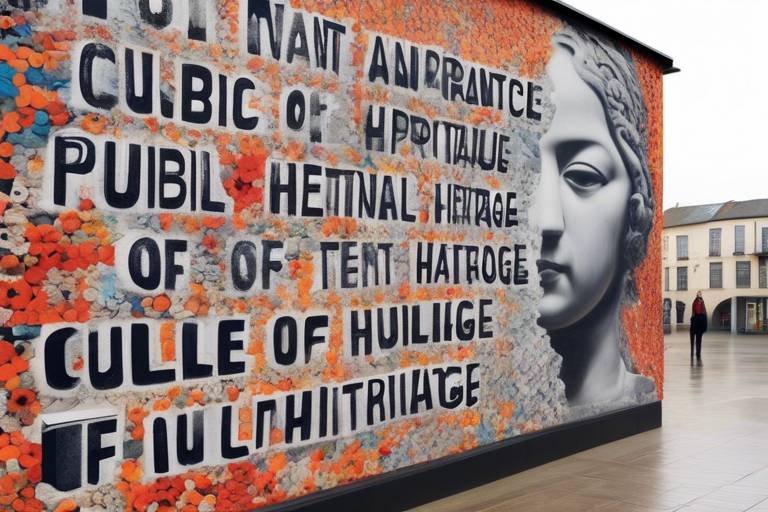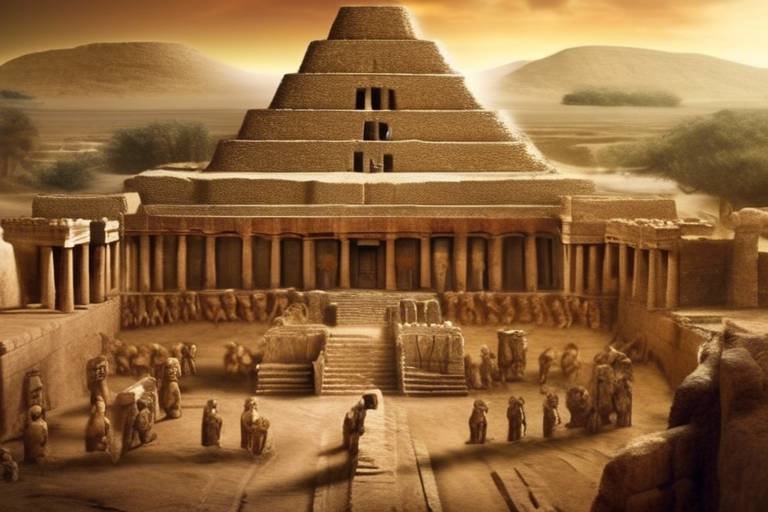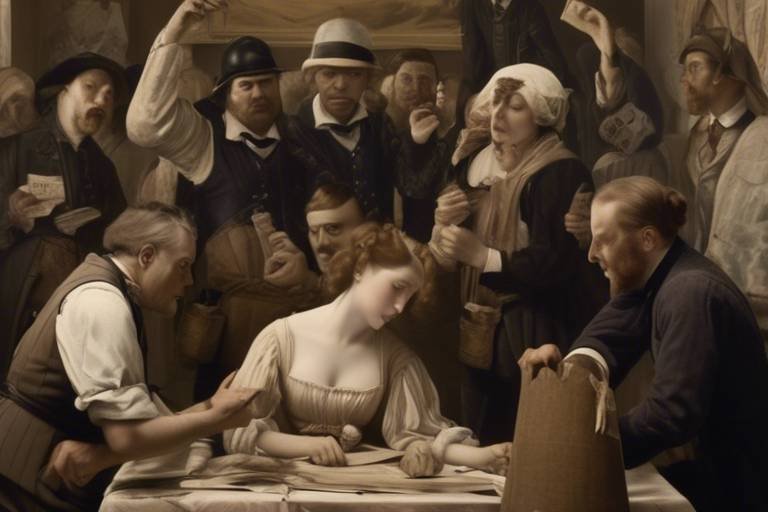The Intersection of Religion and Magic in Antiquity
The intersection of religion and magic in antiquity unveils a fascinating tapestry of intertwined beliefs and practices that shaped ancient societies. In the ancient world, religion and magic were not separate entities but rather intricately connected aspects of spiritual life. Religious practices in ancient civilizations were deeply rooted in rituals, ceremonies, and beliefs that reflected a profound reverence for the divine. These practices often intersected with magical traditions, blurring the lines between the sacred and the mystical.

Religious Practices in Ancient Civilizations
Religious practices in ancient civilizations were deeply intertwined with the daily lives of individuals, shaping their beliefs, rituals, and societal structures. From the majestic temples of Egypt to the sacred ceremonies of Mesopotamia, religion played a central role in the lives of ancient peoples. These practices were not just about worshiping gods and goddesses but also about seeking guidance, protection, and divine favor in various aspects of life.
Ancient civilizations often had a pantheon of deities representing different aspects of nature, human emotions, and cosmic forces. The rituals performed in honor of these gods were elaborate and symbolic, involving offerings, prayers, and sacred dances. Priests and priestesses acted as intermediaries between the mortal realm and the divine, conducting ceremonies and interpreting omens to maintain harmony with the supernatural forces believed to govern the universe.
Moreover, religious practices were not confined to formal ceremonies but permeated all aspects of society. Festivals, processions, and feasts were held to commemorate important events, honor deities, and seek blessings for the community. The construction of temples and shrines was a common practice, serving as sacred spaces where individuals could connect with the divine through prayer, meditation, and rituals.
Symbolism played a crucial role in religious practices, with each god or goddess associated with specific attributes, animals, colors, and symbols. These symbolic representations were used in art, architecture, and religious artifacts to convey deeper meanings and invoke the presence of the divine. The intricate iconography found in ancient temples and tombs reflected the complex belief systems and mythologies of these civilizations.
Overall, religious practices in ancient civilizations were not just about following a set of rules or doctrines but were deeply ingrained in the cultural fabric of society. They provided a sense of meaning, purpose, and connection to the supernatural world, offering solace in times of uncertainty and guidance in navigating the complexities of existence.

Magical Beliefs and Practices
Magical beliefs and practices in antiquity were deeply intertwined with the spiritual and supernatural aspects of ancient societies. The ancient practitioners of magic believed in harnessing mystical forces through spells, incantations, and rituals to influence the world around them. These magical practices often involved the use of talismans, amulets, and divination methods to seek protection, guidance, or control over natural and supernatural elements.
One of the key aspects of magical beliefs in antiquity was the concept of sympathetic magic, where practitioners believed that like affects like. By performing certain rituals or using specific objects, they aimed to create a connection between the physical world and the spiritual realm, influencing outcomes through symbolic actions. These practices were not only about manipulating external forces but also about internal transformation and personal empowerment.
Moreover, magical beliefs often intersected with religious practices, blurring the lines between the sacred and the profane. Priests and priestesses, who held significant roles in religious ceremonies, also practiced magic to communicate with deities, interpret omens, or perform healing rituals. The boundaries between religion and magic were fluid, with both serving as means to access divine power and navigate the uncertainties of life.
Archaeological discoveries have provided valuable insights into the material culture of magical beliefs in antiquity. From inscribed amulets to magical texts, these artifacts shed light on the symbols, rituals, and spells used by ancient practitioners. The symbolism and iconography associated with magical practices often reflected broader cultural beliefs and cosmological principles, offering a glimpse into the worldview of ancient societies.
Magical texts and manuscripts found in archaeological sites contain a wealth of information about the rituals and incantations used by ancient practitioners. These texts not only reveal the techniques and formulas employed in magical practices but also provide clues about the social context in which these practices were performed. The study of magical texts offers a window into the beliefs, fears, and aspirations of ancient people seeking to navigate the mysterious forces of the universe.
The legacy of magical beliefs and practices in antiquity continues to influence modern spiritual traditions and occult practices. Elements of ancient magic, such as the use of symbols, incantations, and rituals, have been incorporated into contemporary esoteric systems and New Age movements. The enduring fascination with magic reflects a timeless human desire to explore the boundaries of reality, seek hidden knowledge, and tap into the mysteries of the unseen world.

Role of Priests and Priestesses
In the ancient world, priests and priestesses held a unique position of power and influence, serving as intermediaries between the divine realm and the mortal world. These religious leaders played a dual role, acting as spiritual guides for their communities while also engaging in magical practices to appease the gods and ensure prosperity and protection. They were not only responsible for conducting religious ceremonies and rituals but also for performing magical incantations and spells to invoke supernatural forces and blessings.
One of the key responsibilities of priests and priestesses was to maintain the connection between the human realm and the divine realm through their rituals and offerings. They served as the mouthpieces of the gods, interpreting their will and conveying their messages to the people. Through their intimate knowledge of religious texts and practices, priests and priestesses guided individuals in seeking divine favor, healing, and protection against malevolent forces.
Moreover, priests and priestesses were often revered for their ability to access the supernatural realm and communicate with deities on behalf of their communities. They were believed to possess special powers and insights that allowed them to perform miracles, prophesy future events, and provide spiritual guidance in times of need. Their roles extended beyond mere religious duties to encompass a deeper connection with the mystical forces that governed the universe.
Within ancient societies, the authority and prestige of priests and priestesses were unparalleled, as they wielded significant influence over matters of faith, morality, and social order. Their involvement in both religious and magical practices underscored the interconnectedness of these two realms, highlighting the blurred boundaries between the sacred and the supernatural. Through their rituals and ceremonies, priests and priestesses sought to maintain harmony between the earthly realm and the divine realm, ensuring the well-being and prosperity of their communities.

Divine Intervention and Supernatural Forces
When delving into the realm of ancient societies, one cannot ignore the intricate dance between divine intervention and supernatural forces. These civilizations viewed their gods and goddesses not only as distant deities but as active participants in their daily lives, capable of influencing the world in profound ways. The concept of divine intervention was deeply ingrained in religious practices, where prayers, sacrifices, and rituals were performed to seek the favor of the gods and avert their wrath.
Moreover, the belief in supernatural forces permeated every aspect of ancient life. From the forces of nature to unseen spirits, ancient societies held a complex understanding of the invisible powers that governed the world. These supernatural forces were not merely abstract concepts but tangible entities that could be appeased or invoked through various rituals and magical practices.
One striking example of divine intervention and supernatural forces can be seen in the ancient Egyptian belief in the god Ra, the sun god who was believed to traverse the sky each day, bringing light and life to the world. The Egyptians performed elaborate rituals and built temples in honor of Ra, seeking his blessings for a bountiful harvest and protection from harm.
Similarly, the ancient Greeks revered the goddess Athena, associating her with wisdom, warfare, and civilization. They believed in her divine intervention in times of conflict and sought her guidance through oracles and divination practices. The intricate tapestry of divine intervention and supernatural forces shaped the religious and magical landscape of these ancient civilizations, influencing every aspect of their beliefs and practices.

Artifacts and Archaeological Discoveries
Artifacts and archaeological discoveries provide invaluable insights into the intertwined relationship between religion and magic in antiquity. Through the excavation of ancient sites, researchers have unearthed a wealth of material evidence that sheds light on the beliefs and practices of ancient civilizations. From amulets and inscriptions to temples and figurines, these artifacts offer a glimpse into the spiritual and mystical world of the past.
One fascinating aspect of these discoveries is the presence of symbolic representations and iconography that reveal the deeper meanings associated with religious and magical practices. For example, the use of certain symbols on amulets or in temple decorations may have held specific significance related to protection, healing, or divination. By studying these symbols, researchers can unravel the intricate connections between religion and magic in ancient societies.
In addition to physical artifacts, archaeological excavations have also unearthed a treasure trove of magical texts and manuscripts. These ancient documents contain a variety of spells, incantations, and rituals that were used by practitioners of magic in antiquity. By examining these texts, scholars can gain valuable insights into the methods and beliefs surrounding magical practices, as well as their integration with religious traditions.
Overall, the study of artifacts and archaeological discoveries plays a crucial role in our understanding of the intersection of religion and magic in the ancient world. By analyzing the material remains left behind by ancient civilizations, researchers can piece together the puzzle of how these two realms overlapped and influenced each other, leaving a lasting legacy that continues to fascinate and intrigue us today.

Symbolism and Iconography
Symbolism and iconography played a crucial role in ancient religious and magical practices, serving as powerful tools for conveying deeper meanings and connections. In the intricate tapestry of symbols and imagery, each element held significance beyond its physical representation, carrying layers of hidden meanings that enriched the spiritual experience. For example, the use of certain animals like the snake or the owl symbolized specific qualities or deities, while geometric patterns and colors conveyed cosmic harmony and divine order.

Magical Texts and Manuscripts
Magical texts and manuscripts from antiquity offer a fascinating glimpse into the mystical practices of ancient civilizations. These ancient writings contain a wealth of knowledge regarding magical spells, incantations, and rituals that were used by practitioners seeking to harness supernatural forces. One notable example is the Egyptian Book of the Dead, a collection of spells and prayers intended to guide the deceased through the afterlife. Such texts provide insights into the beliefs and practices of ancient societies, shedding light on their understanding of the supernatural realm.
Furthermore, magical manuscripts often served as instructional guides for individuals looking to perform specific rituals or spells. These texts were carefully preserved and passed down through generations, highlighting the importance placed on magical knowledge in ancient cultures. The Key of Solomon, a medieval grimoire attributed to King Solomon, is one such example that details various rituals for summoning spirits and casting spells.
Magical texts were not only practical guides but also held symbolic significance within the religious and magical contexts of the time. Symbols and glyphs featured in these manuscripts were believed to possess powerful protective or transformative properties when used in rituals. The intricate illustrations and intricate calligraphy found in these texts were not merely decorative but held deeper meanings that were integral to the efficacy of the magical practices they described.
Moreover, the transmission of magical knowledge through texts played a crucial role in the preservation and dissemination of magical traditions. These manuscripts were often considered sacred and were entrusted to the care of priests, scribes, or secret societies dedicated to the study of the occult. The Necronomicon, a fictional grimoire created by author H.P. Lovecraft, exemplifies the mystique and allure associated with ancient magical texts.
In conclusion, magical texts and manuscripts from antiquity provide a window into the mystical worldviews and practices of ancient civilizations. These ancient writings not only offer practical instructions for performing magical rituals but also serve as repositories of symbolic and esoteric knowledge. By studying these texts, modern scholars can gain valuable insights into the intersection of religion and magic in the ancient world, enriching our understanding of the spiritual beliefs and practices of our ancestors.

Legacy and Influence on Modern Practices
When delving into the legacy of ancient religious and magical practices, we uncover a rich tapestry of influences that continue to shape modern spiritual beliefs and traditions. The mystical rituals and beliefs of antiquity have left an indelible mark on contemporary practices, weaving a thread of continuity through the fabric of time.
One of the most prominent legacies of ancient religious and magical practices is the enduring fascination with the supernatural and the unseen. The belief in divine intervention and the existence of supernatural forces continues to captivate the human imagination, manifesting in various forms of modern spirituality and occult traditions.
Moreover, the symbolism and iconography associated with ancient religious and magical practices have seeped into modern art, literature, and popular culture. The intricate symbols and imagery that once adorned temples and artifacts now find new life in contemporary interpretations, carrying with them layers of meaning and significance.
Furthermore, the ancient texts and manuscripts that contain magical spells and rituals offer a glimpse into the mystical world of the past, inspiring modern practitioners to explore the boundaries between the mundane and the magical. These texts serve as a bridge between the ancient and the present, connecting us to a legacy of knowledge and wisdom.
As we navigate the complex tapestry of ancient religious and magical practices, we are reminded of the profound impact that these beliefs have had on shaping human consciousness and spiritual exploration. The legacy of antiquity lives on in the rituals we perform, the symbols we revere, and the mysteries we seek to unravel.
Frequently Asked Questions
- What is the significance of the intersection between religion and magic in antiquity?
The intersection of religion and magic in antiquity highlights the interconnectedness of spiritual beliefs and mystical practices in ancient societies. It demonstrates how these two realms influenced each other, shaping cultural norms and belief systems.
- How did religious practices in ancient civilizations overlap with magical traditions?
Religious practices in ancient civilizations often incorporated elements of magic, such as rituals, ceremonies, and beliefs aimed at invoking supernatural forces. This overlap blurred the lines between the sacred and the mystical, showcasing a complex relationship between the two.
- What role did priests and priestesses play in the practice of magic and religion?
Priests and priestesses in ancient societies served as both spiritual leaders and practitioners of magical rituals. They wielded significant influence in shaping belief systems, acting as intermediaries between the divine and mortal realms.
- How did ancient civilizations perceive divine intervention and supernatural forces through religious and magical practices?
Ancient societies viewed gods, goddesses, and supernatural entities as integral parts of their religious and magical beliefs. Through rituals, prayers, and magical incantations, individuals sought to communicate with and appease these higher powers for various purposes.
- What archaeological evidence supports the interconnectedness of religion and magic in antiquity?
Artifacts such as inscriptions, talismans, and temples provide tangible proof of the intersection between religion and magic in ancient times. These discoveries offer insights into the material manifestations of spiritual practices and mystical traditions.


















